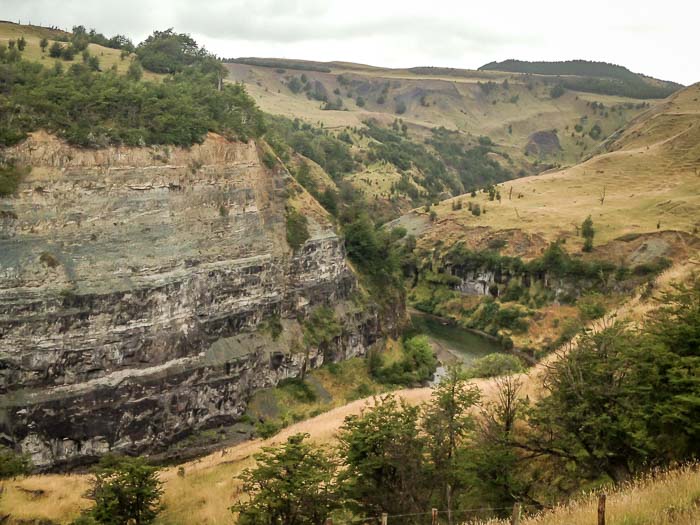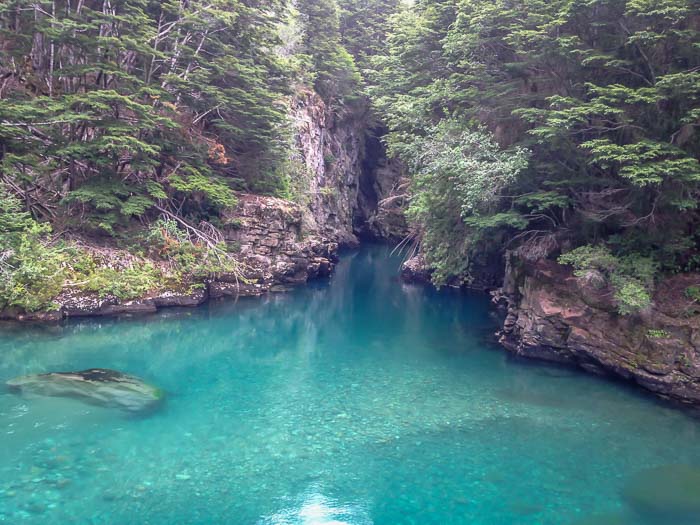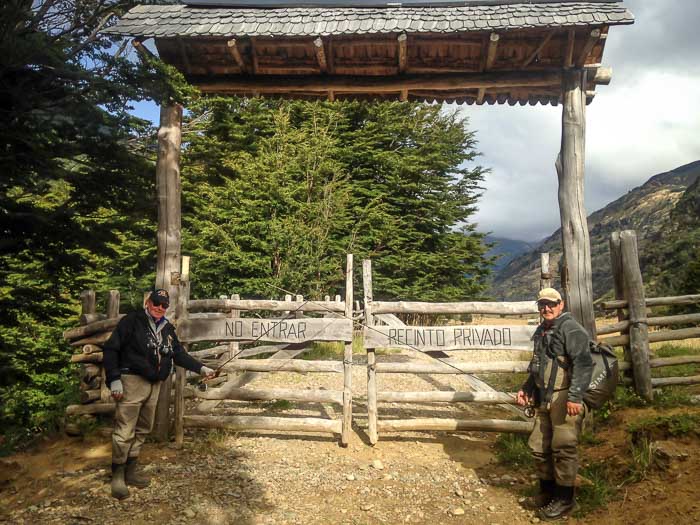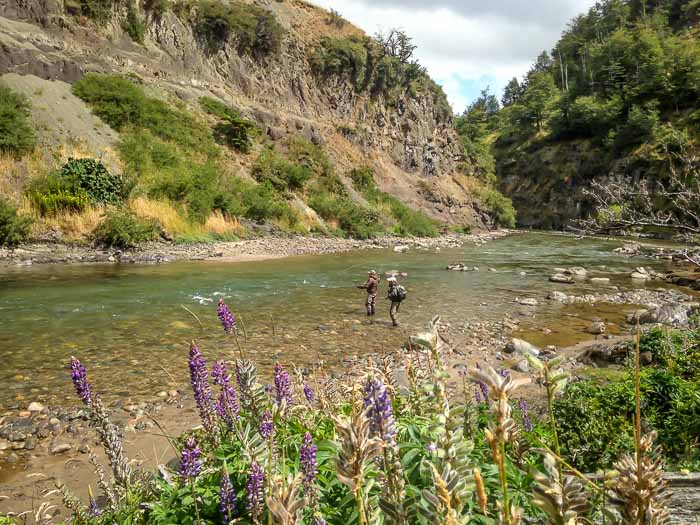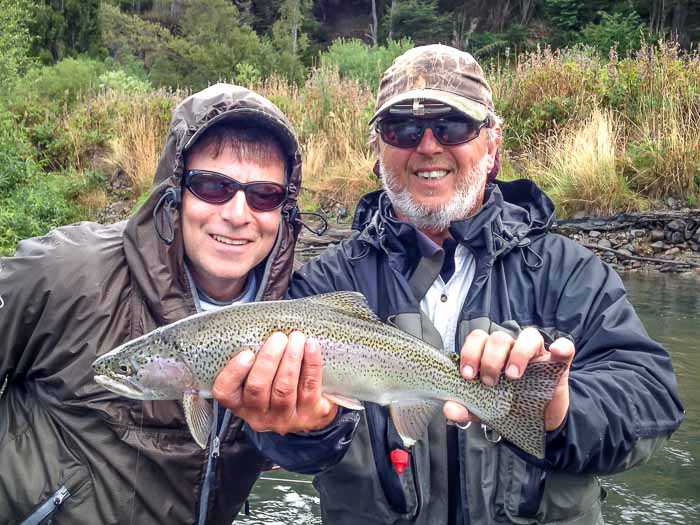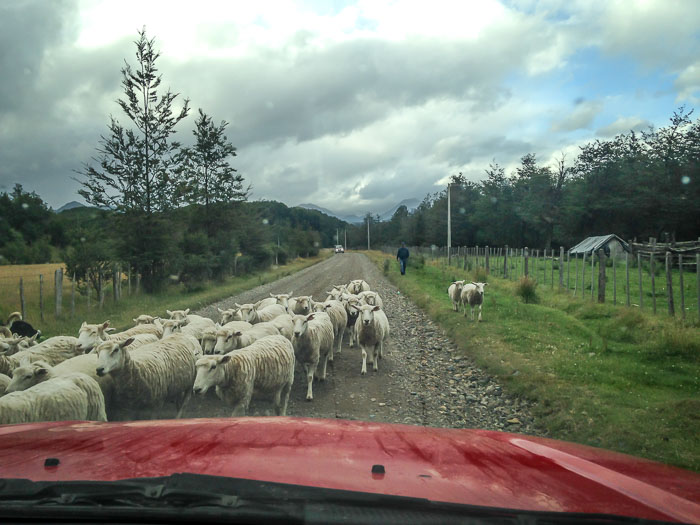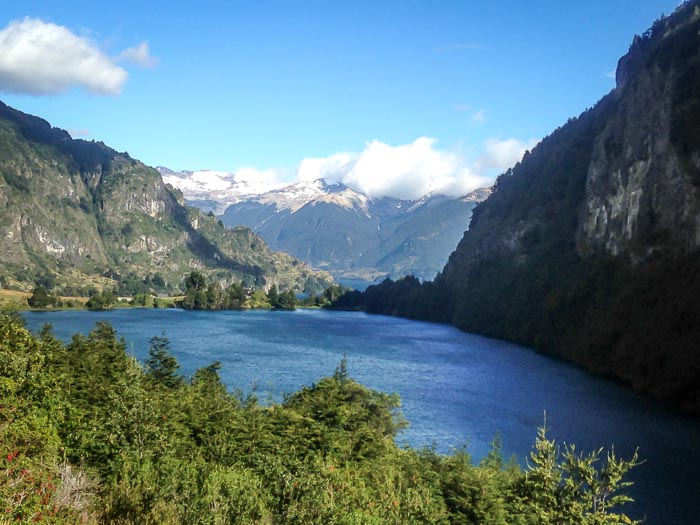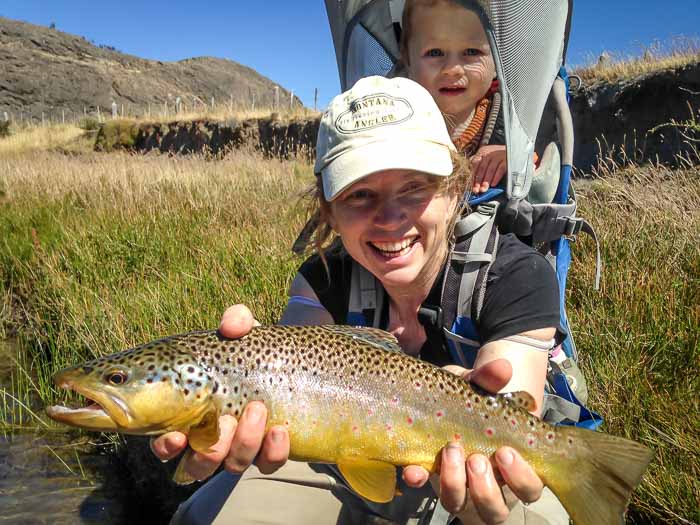
By Matt Morris:
A dozen years ago, I watched a fly fishing film on Patagonia. The movie glorified adventure fly fishing in solitude on untouched trout streams. Big glaciated mountains shot straight up out of the ground, while anglers crushed large trout on dry flies. I immediately put a fishing trip to Patagonia at the top of my bucket list. Due to the remoteness and cost, there was some uncertainty of it ever becoming a reality, and then it was. This year, I was fortunate enough to host a group of eight anglers; five of which were clients I had fished with over the years through Montana Angler. Generally speaking, the month of February is in the heart of summer in Patagonia. It provides the best chances of favorable weather along with reliable dry fly fishing. However, there is a saying in Patagonia that goes something like this: “if you are trying to predict the weather in Patagonia you are either new to the area or you're an idiot.” In other words, when you're fishing at the end of the world, near giant sheets of ice that measure over a thousand square miles, the weather is hard to predict. We found out the hard way on our trip. The day we arrived at Magic Waters Patagonia Lodge, the temperature dropped nearly 20 degrees and the wind howled for four days. Fishing conditions were challenging at times, and even more so for anglers not experienced with fishing in the wind. The less than favorable weather limited some of our daily options and required us to nymph fish at times. Even though the weather didn't cooperate with us everyday, the trip was highly successful. This report is from my experience only. The guys I hosted have their own stories to tell, a few that I heard went like this: -“we caught at least fifty fish” -“I caught the biggest fish in the 7 years I have fished Patagonia” -“it was so windy, it was hard to stand up” -and my favorite: “I was just getting ready to yell at Chad for casting over my line when a huge 25” brown ate my dry fly and I missed him because I was going to yell at Chad. I threw the fly back in there out of frustration and missed him the second time because I wasn't expecting him to eat it again.”
Day 1: Simpson River Private Access Wade Fishing
A short 20 minute drive through rolling green hills brought us to a series of gates. During our stay at Magic Waters, I became very familiar with Patagonian gates. Eduardo, has done an excellent job of securing private access. Every gate in Patagonia has its own unique character. Eduardo parked on a bluff overlooking a beautiful canyon formed by the Simpson River. We followed a trail 300 feet down to the river and immediately observed a fish eating mayflies on the surface at the tail of a nice run. A few casts with a parachute adams trailed behind a large stimulator brought the 15 inch rainbow to hand. I continued fishing a double dry setup with good success while Craig and Eduardo went ahead. As the wind picked up and blew the mayflies into Argentina, I switched over to a Pats rubber leg and a pheasant tail nymph rig. Although it was challenging to cast at times, it seemed like if you could get your flies in the water, they were going to get eaten.
After a great nymphing session, Eduardo brought me to a huge pool with several Chinook Salmon sitting near the bottom. The pool had no protection from the increasing wind, but we rigged my 9 weight anyway. Fifteen minutes of flailing away rewarded me with a few trout and a stinging noggin as my flies bounced off my head several times. With the Chinooks spooked, I admitted defeat and vowed to sight fish to them again upon our return. Fishing for Chinooks in small, clear water is a blast as its all sight fishing, and they are huge! However, its challenging because too often, they can see you. I worked upstream through very productive pocketwater. After around 30 interactions with trout in the 14-17 inch range, I decided to switch back to a dry fly. Although the fishing was significantly slower, there was enough action to keep interest.
Day 2: Palomo River Private Access Wade Fishing
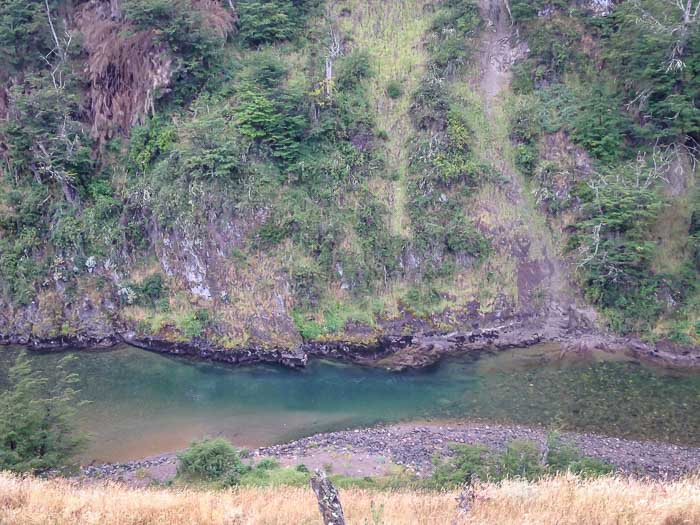
A very scenic hour and fifteen minute drive past large lakes, lagunas, glaciated peaks and jungly vegetation brought us to an entirely different ecosystem than the previous day. We parked in front of a gate with a sign that read “No entrar Recinto Privado.” My spanish is rusty, but I think that translates to “great fishing past gate.” With Eduardo's access, we passed through the gate and walked for five minutes. Our first introduction to the river was a large, slow pool with several fish eating on the surface and beneath the surface. Ron and I were excited for the day, as sight fishing is as good as it gets in our books. Our guide, Marcelo, and Ron fished the pool, as I fished the run below. There I found a half dozen trout willing to eat my big Chubby Chernobyl dry fly. I continued working my way upstream sight fishing, but also shooting long casts under overhanging vegetation along the banks. Sometimes, while fishing this scenario, I opted to use what I call the “real natural presentation” for the beetles that we were imitating. This presentation works great because the fish in Patagonia are not particularly leader shy. We were fishing large dry flies on a 2X leader. In order to achieve a “real natural presentation” you must cast your fly high into the vegetation, give it a series of yanks, each yank slightly harder than the previous, until the fly falls out of the vegetation and into the water. Just as a real beetle would. This may be the purest presentation in all of fly fishing. I don't mean to brag, but I have nearly perfected it. Eventually I met up with Ron and Marcelo. It was then we enjoyed a classic sight fishing moment, A healthy rainbow was eating mayflies on the surface, tight to a log on the opposite side of the river. Ron was able to punch the perfect cast and soon had a big jumping rainbow on the end of his line. The big fish tore off line as he ran downstream and suddenly Rons line went limp. This led us into a hilarious discussion about knot tying. Poor Marcelo handled it well. We ate a nice lunch and Marcelo rigged us up for streamers as we were entering his favorite streamer section. I should have carefully checked my leader for wind knots as I was using my “real natural presentation” earlier in the day. It only took about three casts to realize my error as I watched a big brown rip my streamer right off of my line. A lesson learned the hard way once again. I re-rigged and had some fast and furious streamer action. Ron must have forgiven Marcelo about the knot tying incident as he let Marcelo fish the nicest looking streamer water that you could dream of. Marcelo proved himself with a beautiful 20 inch brown. Marcelo turned Ron loose, and hiked me to the tailout of the lake where he knew of an enormous brown. It didn't take Marcelo long to spot the 28 inch brown. He was smart as he sat in a very technical spot near a log about five feet from the bank. The bank was very steep, about thirty feet high and covered with thick vegetation. I bushwhacked down into casting position as Marcelo keep me orientated with the monster. I immediately tried my “real natural presentation”, but it doesn't work as well on the backcast. A few minutes of fumbling around got me back into position. I couldn't get a good enough presentation and he soon tucked himself in under the log. It was another terrific day of fishing in Patagonia. The day was packed with sight fishing, long technical casts (if you wanted), a stunning setting, and a shot at a legendary fish.
Day 3: Paloma River Canyon Float Fishing Adventure
On the drive to the Paloma River the previous day, the road crossed a high bridge over a stunning, sheer walked canyon with a jungle canopy. I told Marcelo that I would like to go down there. A discussion was in order with Monte, the whitewater guide. As it turned out, the canyon contains four technical rapids that haven't been classified, as Monte only knows of one other person who has rowed the canyon. Monte had only rowed the canyon twice previously and never at the current water flow. In Patagonia, guides don't have the convenience of looking at the USGS river flow charts that the Montana guides often rely on. The guides must use past experiences and educated guesses. Monte informed me that if something went wrong, I may have to swim out of the remote canyon, as there would be no other way of exiting. I had confidence in Montes skills, as he was a guide on the Grand Canyon for several years. Some of his other life achievements include being a ski buddy with extreme skiing legend Doug Coombs, a 10 second ski clip in a Warren Miller ski movie, and being perhaps the first person to row and swim a technical stretch of the Rio Baker in Patagonia. I knew I was in good hands.
We pulled into a small farm past the chickens, dogs, sheep and a oxen cart equipped with wooden wheels to ask permission to access the “boat ramp.” The farmer asked “are you sure you want to go down there, aren't you scared?” He then granted us permission. As Monte rigged the boat, I went upstream and caught a few fish on a big dry fly. I considered the fish a bonus, as this was more of a day of adventure that a serious day of fishing. With the boat rigged, we pushed off and Monte had me into another trout right away. Soon after, we entered the canyon and there was no turning back. We stopped along the way to scout rapids and fish. The water had a gorgeous blueish hue to it; it was so clear you could see fish on the bottom of 25 foot deep pools. We had lunch on a rock island that emerged 20 feet above the river. I had to wonder how the enormous tree that we used as a chair ended up so high above the river. After lunch I grabbed my rod and shot casts at the fish we were watching during lunch. After around 10 interactions with fish we pushed off. The biggest rapids were still to come so I broke down my rod for safety purposes. Monte did an outstanding job navigating down the river, I'm not sure how anyone could have rowed a cleaner line. After the rapids, the entire river pinched down into a 100 foot slot with sheer cliff walls. I felt no need to fish anymore during the float, as I had already caught more than my share of fish the past three days. The scenery was too spectacular to miss.
Day 4: Lower Simpson River Wade Fishing
Several options for the day were laid on the table. The weather was cool, rainy and overcast. It didn't look like an ideal day to visit a smaller river and throw dry flies, so I opted to hit a different section of the Simpson. The hour long drive to the fishing was phenomenal. None of us had ever seen so many brilliantly colored rainbows in our lives. Nearly everywhere you looked, there was a rainbow.
It was a short hike down to the river, I went ahead streamer fishing while Craig and Alex worked a run. The river was slightly off color, and in my opinion looked perfect for streamers. It didn't take long to bring a few nice browns to the hand and have several chases. Craig and Alex caught up, Craig had netted about five fish in a short time frame. We walked upstream to a big deep pool. Alex said the pool was home to a 26 inch brown and that I should fish it while they went ahead. I worked through the pool once with no luck, but thought there must be a fish in there somewhere. I decided to walk to the top of the run and work my way down again. I tried a different approach this time. I casted a little further upstream with my sinking line, fed some slack and got my streamer down real deep, and slowly twitched it while it swung across the current. About halfway down the run, it got eaten. The fish was heavy and hard to move. He stayed deep near the bottom and shook his head. He was was hard to move. There were no big runs or jumps, just deep headshakes, and an intense game of tug-a-war. I was just about to call Alex over for a photo opportunity when the line went limp. My heart sank and profanity echoed off the canyon walls. I brought my line in expecting my streamer to be missing. The streamer was still on, but one of the hooks had been broken off. I was sick. I walked upstream to where Alex and Craig were fishing, I took a seat, and cracked a beer. The sound of a beer cracking open must have called the big fish in, as it didn't take Craig long to put a pair of 20 inchers in the net. Craig was on fire with his nymph setup, so I copied it and nymphed the next run up. The nymph fishing was very good as I was able to trick several 16-18 inch fish right away. Patagonia fish seem to be exceptionally strong fighters. Maybe its because they haven't been caught before, or that they don't get caught very often. All of the fish are thick. The river began to clear up, but I kept nymphing using the “if its not broke then why fix it” mentality. We tricked plenty more trout and before we knew it, it was time to go.
Day 5 Middle Simpson Private Access Wade Fishing
The original plan for the day was to fish Blue Lake; a gorgeous lake with excellent sight fishing. I had been wanting to see Blue Lake for several years. We hooked the boat up and headed out. On the drive, the wind picked up and was ferocious. Lake fishing can be very challenging in heavy winds, not only for the angler but also for the unfortunate person who has to row the boat. We decided to pull over and discuss some other options. Alex mentioned several options, but Craig and I were most interested in trying to hit the nocturnal stoneflies on the middle section of the Simpson River. The Simpson had been on fire, offered beautiful scenery, a chance of hooking a huge fish, high fish counts of quality fish, and shots at Chinook Salmon. It seemed to be an easy decision.
Alex soon pulled up to a small farm to check in; once again we were fishing private access. A two minute walk brought us to the river. The wind was blowing so hard, I couldn't tell which direction the river was flowing. Alex turned over several rocks, looking for evidence of a recent hatch, but found no evidence. Although we didn't see any bugs offhand, that doesn't mean that they are not present. I tied on a rig that we frequently use in Montana called the Chubby Rubby; which is a big Chubby Chernobyl dryfly with a Pats Rubblerleg nymph dropper. I walked to the bottom of a run, with the wind at my back and opted to use the flagpole cast. The flagpole cast requires very little effort and is an effective way to fish in high wind situations. To do the flagpole cast: position yourself so the wind is at your back, stip out a bunch of line, raise your rod tip, let the wind blow your flies to the top of the run, and then lower your rod tip so the flies land in the water. Once the flies are on the water, keep your rod tip low and don't mend. A high rod tip or a mend will cause your flies to be blown off the water.
After fishing several runs using the flagpole casts, I had at least a dozen fish to the hand. The fish were eating both flies, but as the day warmed and the wind calmed they keyed into the big dry fly. I eventually opted to fish a single big dry fly which proved to be a good choice as another dozen or so fish were fooled. It was time for lunch, Craig and Alex were sitting on the bank eating. Rather than reel up, I casted my line into the river and set my rod down in the rocks. As soon as I sat down, kaploosh! Fish on! I ran over to my rod and set the hook. This day was on the verge of becoming ridiculous. The wind was no longer a factor, the sun popped out and the fishing got better. I quit wading in the water to position myself into casting position and opted to shoot long 60 foot casts from high upon the bank. I could see fish moving over 10 feet to eat my big dry. It was an amazing day of dry fly fishing for both numbers of fish and the quality of fish. There was not the slightest feeling of disappointment for choosing to fish the Simpson River for three days of a six day trip. In fact, I wanted to go there again on the last day!
Day 6: Private Access Hog Hunting
On our last scheduled day of fishing, I opted to try my luck for a trophy sized fish. Monte knew of a laguna nearby that had a reputation of anglers catching an exceptionally large fish or being skunked. A short 10 minute drive from the lodge brought us to a locked gate. I offered my assistance, but Monte refused at he hopped out of the truck with a keyring full of keys. Whomever chose to lock the gate wasn't messing around. There were three working locks on separate chains on one gate! I began to think that this may be a very special place that we are going to. After getting everything secured behind us we drove a couple hundred yards to another gate locked with three working locks! It was then I knew that this was going to be a special place.
The laguna was lined with wildflowers, a dock, and had a nice pontoon boat waiting for us. We quickly our way over to Monte's favorite corner of the laguna. It was there we started hearing big toilet flush rises. Big fish make that sound when they feed on the surface. We assumed the fish were eating dragonflies when all of a sudden a huge upper twenty inch rainbow zigzagged near the surface. He was looking up, occupied chasing a dragonfly and nearly crashed into the boat. We were seeing positive signs of activity, so Monte tied the boat up to the reeds along the shoreline. I insisted that Monte fish along with me, he skated a huge Gypsy King dryfly while I stripped a olive wooly bugger and callibaetis trailer under a sinking line. It wasn't long until I tied into a toad. After several long runs and deep dives we finally got him into the net. This boy had NFL shoulders and barely fit into the net. Monte handed me the net while he dug for his camera bag. I unhooked my flies as I was using two flies on 0x. On several occasions, I've had fish swim away with one fly in his mouth and the other fly stuck in my hand. If this scenario happened with a fish this size on 0X, it would be ugly. As I lifted the fish out of the net, the leader wrapped around the fish. I held the fish off the bottom of the net so I could clear the leader, and he made his move. A feeling of desperation ran through my body as I no longer had a firm grasp on the trophy. As I watched him bounce off the raft tube and splash into the water. Monte, who had his head down, looks up from his camera bag with a look of disbelief and says “what did you do that for?” Those words haunted me for the remainder of the day, as that was our only fish. Day 7 Bonus Day All of the clients that I was hosting flew home, while my wife, Laura, and 17 month old daughter, Nettie, flew in to start their two week adventure. Eduardo invited us to join his family for some fishing and swimming on a small wade fishery that was an hour and forty five minute drive from the lodge. We happily accepted and were not disappointed. It was a warm day and the hoppers were out enjoying the sunshine.
The banks were just high enough to give us a great viewpoint. The browns were easy to spot as they were floating near the surface. At one point, I casted my grasshopper between two 17 inch browns and watched them both try to attack it. By the end of the day, Nettie just about had perfected saying “bye,bye fish” as the fish were released. Fly fishing in Patagonia was everything I had heard it to be: untouched, remote, lots of fish, huge fish, Montana 50 years ago. The fishing was so good, with beautiful scenery, limitless options, and no competition that upon my return, I immediately put a fly fishing trip to Patagonia back on the top of my bucket list.

